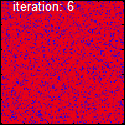Brusselator: Difference between revisions
m link [sS]ulfuric acid |
mNo edit summary |
||
| Line 12: | Line 12: | ||
The '''Brusselator''' is a theoretical model for a type of [[autocatalytic reaction]]. |
The '''Brusselator''' is a theoretical model for a type of [[autocatalytic reaction]]. |
||
The Brusselator model was proposed by [[Ilya Prigogine]] and his collaborators at the [[Université Libre de Bruxelles]]. |
The Brusselator model was proposed by [[Ilya Prigogine]] and his collaborators at the [[Université Libre de Bruxelles]].<ref>{{cite web |
||
| url = http://www.idea.wsu.edu/OscilChem/#Brusselator%20Model |
| url = http://www.idea.wsu.edu/OscilChem/#Brusselator%20Model |
||
| title = IDEA - Internet Differential Equations Activities |
| title = IDEA - Internet Differential Equations Activities |
||
Revision as of 10:52, 18 October 2023



The Brusselator is a theoretical model for a type of autocatalytic reaction. The Brusselator model was proposed by Ilya Prigogine and his collaborators at the Université Libre de Bruxelles.[2]
It is a portmanteau of Brussels and oscillator.
It is characterized by the reactions
Under conditions where A and B are in vast excess and can thus be modeled at constant concentration, the rate equations become
where, for convenience, the rate constants have been set to 1.
The Brusselator has a fixed point at
- .
The fixed point becomes unstable when
leading to an oscillation of the system. Unlike the Lotka–Volterra equation, the oscillations of the Brusselator do not depend on the amount of reactant present initially. Instead, after sufficient time, the oscillations approach a limit cycle.[3]
The best-known example is the clock reaction, the Belousov–Zhabotinsky reaction (BZ reaction). It can be created with a mixture of potassium bromate , malonic acid , and manganese sulfate prepared in a heated solution of sulfuric acid .[4]
See also
References
- ^ Lukas Wittmann. "BACHELOR'S THESIS - DEVELOPMENT OF A PYTHON PROGRAM FOR INVESTIGATION OF REACTION-DIFFUSION COUPLING IN OSCILLATING REACTIONS".
- ^ "IDEA - Internet Differential Equations Activities". Washington State University. Retrieved 2010-05-16.
- ^ http://www.bibliotecapleyades.net/archivos_pdf/brusselator.pdf Dynamics of the Brusselator
- ^ BZ reaction Archived December 31, 2012, at the Wayback Machine













